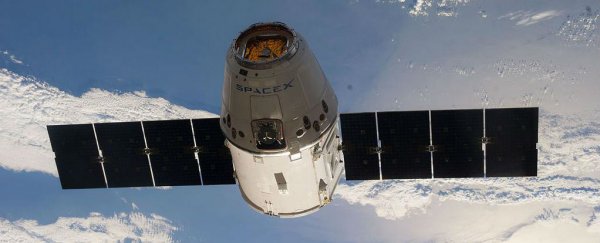Its first attempt in January ended with a spectacular crash, while the second attempt in February was called off due to bad weather. Now, SpaceX will have another crack at bringing the first stage of its Falcon 9 rocket down for a soft landing at sea.
The company, led by the always-innovative Elon Musk, is slated to launch its unmanned Dragon spacecraft atop the two-stage Falcon 9 rocket from Cape Canaveral Air Force Station in Florida at 4:33 PM EDT on Monday April 13 (or 6:33 AM on Tuesday April 14, Australian EST).
If the launch doesn't go ahead as scheduled, NASA says the next launch window will be at 4:10 PM on Tuesday April 14 (or 6:10 AM on Wednesday April 15, Australian EST).
This is the sixth of 12 delivery missions that SpaceX will carry out for NASA under the terms of a $1.6 billion contract, and it will give the company another crack at making history: turning one-off rockets into reusable vehicles that might dramatically cut the cost of launch missions, and ultimately, space travel.
Ten minutes after launch, SpaceX will try to land the first stage of the rocket on an autonomous barge floating in the Atlantic Ocean.
"The weather was terrible on the second attempt, and it looks like the weather is significantly better [this time]: four to six feet swells," said Hans Koenigsmann, SpaceX vice-president for mission assurance, in a televised NASA briefing.
Koenigsmann said there had been changes made to the drone ship stationed at sea to help it maintain its position and tolerate higher wind and swell levels. He also pegged the company's chances of success at between 75 and 80 percent.
While the soft-landing might be the more hotly anticipated event, it's secondary to the main objective of the mission, which is to resupply the International Space Station (ISS). The Dragon capsule will deliver about 2,000 kg (4,300 pounds) of supplies to the crew, including food, water, equipment and science experiments.
One of the more unconventional items being delivered to the ISS is a customised espresso machine - a special delivery for Italian astronaut Samantha Cristoforetti, who has been on the ISS since January, and says she's getting tired of the instant coffee.
If all goes according to plan, the Dragon capsule should arrive at the space station some 33 hours after the launch. Astronauts onboard, including Cristoforetti, will be tasked with capturing the spacecraft using a robotic arm, and safely bringing it into a docking port.
After about five weeks in orbit, the Dragon capsule will return to Earth, splashing down in the Pacific Ocean, loaded with items no longer needed on the ISS.
"It will stay up there for 35 days, which is the longest we've ever done, I believe," Koenigsmann said.
You can watch the launch live at space.com.
Source: Space.com
